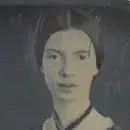
Emily Elizabeth Dickinson
Emily Elizabeth Dickinson is considered one of America’s greatest and most original poets. She was born in Amherst, Massachusetts, into a prominent family with strong ties to the community. After studying at the Amherst Academy, she briefly attended the Mount Holyoke Female Seminary before returning to her family’s home. Though she withdrew increasingly from public life in her later years, Dickinson maintained a wide network of correspondents and intellectual engagement.
Although Dickinson was a prolific writer, her only publications during her lifetime were one letter and ten of her nearly 1,800 poems. The poems published then were usually edited significantly to fit conventional poetic rules. Dickinson’s poetry was heavily influenced by the Metaphysical poets of seventeenth-century England, as well as her reading of the Book of Revelation and her upbringing in a Puritan New England town, which encouraged a conservative approach to Christianity.
Her work challenged the existing conventions of poetry, and she created a distinct poetic voice for her poems, a sharp-sighted observer who sees the limitations of their society as well as imagined escapes. Dickinson created a distinctively elliptical language to express a “house of possibility.” Her poems were unique for her era; they contained short lines, typically lacked titles, and often used slant rhyme as well as unconventional capitalization and punctuation. Many of her poems dealt with themes of death and immortality, aesthetics, society, nature, and spirituality. After her death, her family members found her hand-sewn books, or “fascicles,” with nearly 1,800 poems. Though a selection of her poems were published in 1890, a volume that faithfully captured her original style did not appear until 1955.